- HOME
- Food Storage Basics
- Underground Root Cellar
Build an Underground Root Cellar to Store Your Garden Produce
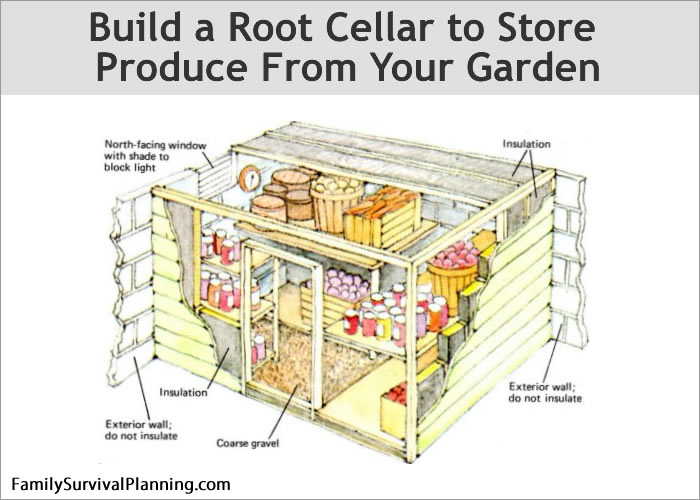
Years ago, before fresh produce was available in supermarkets, root cellars were a useful way to store fruits and vegetables.
If your garden was prolific this year, you might find that an underground root cellar is a great way to have fresh produce for weeks or months throughout the winter.
This method is not particularly useful if you live in an area where winters are warm.
But if you live in an area where the fall and winter are cold, a root cellar might work for you.
Invest in emergency food storage now and enjoy peace of mind for the next 25 years. Don't miss out on the savings!
What fruits and vegetables should you store?
The University of Alaska Fairbanks Cooperative Extension Service in cooperation with the United States Department of Agriculture offers the following chart with storage information for specific produce:
| Vegetables | Temp F. | % Humidity | Storage Time | Comments |
| Beets | 32° | 90–95 | 3 months | Leave 1-inch stem. |
| Brussels sprouts | 32° | 90–95 | 4 weeks | Wrap to avoid drying |
| Cabbage | 38° | 90–95 | 4 months | Late maturing varieties ** |
| Carrots | 32° | 90–95 | 5 months | Top leaving ¼-inch stem * |
| Cauliflower | 32° | 85–90 | 3 weeks | Wrap in leaves * |
| Celery | 32° | 90–95 | 4 months | Dig with roots *** |
| Chinese cabbage | 32° | 90–95 | 2 months | Dig with roots *** |
| Cucumbers | 50° | 85–90 | 3 weeks | Waxed or moist packing * |
| Kohlrabi | 38° | 90–95 | 3 months | Trim leaves * |
| Onions | 32° | 55–60 | 8 months | Dry for two weeks. |
| Parsnip | 32° | 90–95 | 6 months | Top leaving ¼-inch stem * |
| Potatoes | 38° | 85–90 | 8 months | Pack in boxes unwashed. |
| Squash | 60° | 55–60 | 3 months | Winter types, leave 2-inch stem |
| Tomatoes | 60° | 55–60 | 8 weeks | Single layer in covered boxes |
| Turnips | 38° | 90–95 | 3 months | Waxed or moist packing * |
| Small fruits | 32° | 85–90 | 7 days |
* Pack in moistened sawdust or sand.
** Wrap in clean newspaper.
*** Replant in moist sand.
(source)
Fruits like apples and pears can also be stored this way; plus it's a good place to keep all your canned foods if you don't have a basement.
Organizing the Produce For the Longest Storage
Fruits and vegetables should never be stored together and different fruits should not be stored together because they produce a gas called ethylene, which is a ripening gas. The idea here is that you want your produce to ripen naturally and slowly.
Strong smelling produce like cabbage or parsnips should be wrapped in paper so other produce doesn't pick up their odors.
It is important to keep the humidity high (between 80 and 90 percent) so the food doesn't dry out and wrinkle and the temperature should be maintained between 30°F and 40°F.
Be sure to check your produce every week or two and remove any that are spoiling.
Types of Root Cellars
Outdoor Root Cellar

A root cellar can be built out of cement or cinder block and covered on three sides with soil to keep it at an even cool temperature.
Or excavate a large hole, line with wood or concrete, and install a hatch or trap door for the entry. Install an air vent for circulation and humidity control.
Barrels or Steel Drums For Simple Root Cellars
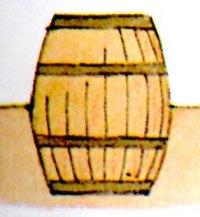
1. For apple storage, start by burying wooden barrel or steel drum halfway in ground.
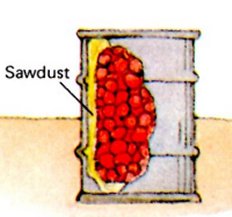
2. If a metal drum is used, line it with sawdust at the bottom and between produce and sides.
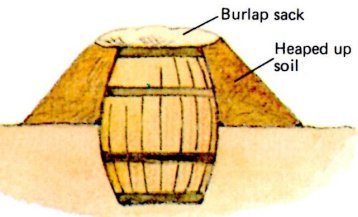
3. Fill barrel or drum with apples. Cover with a leaf-filled burlap sack. Then pile soil around the sides.
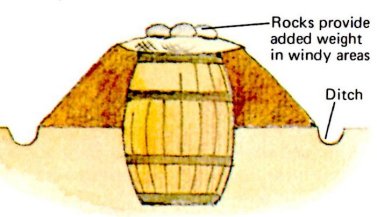
4. Dig a 6 inch ditch around the barrel for drainage. Put rocks on the sack of leaves to keep it in place.
Turn the barrel on its side and store other types of produce.
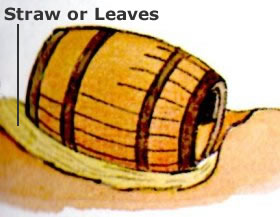
1. Dig a space for the barrel in a well-drained area. Put a bedding of straw or leaves under the barrel and fill it with produce.
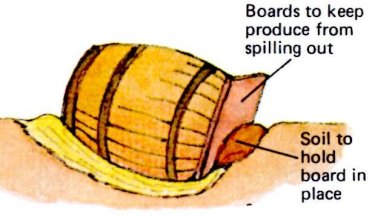
2. Slant the open end down so any moisture will run out, then place a board over the opening.
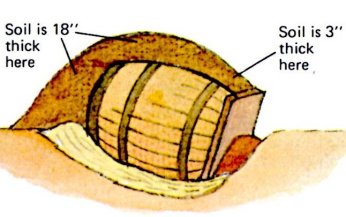
3. Cover the sides and upper end of the barrel with 18 inches of soil. Cover the lower end with 3 inches of soil.
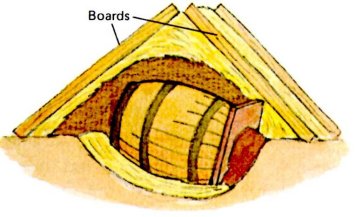
4.Cover everything with straw. Place boards on top to keep the straw from blowing away.
Some types of produce can be stored in warmer areas inside the house, such as, onions, pumpkins, and squash, which need temperatures between 50oF and 55oF with humidity of 60-70 percent. Onions and herbs can be hung upside down in the kitchen.
At the end of the growing season when threat of frost is imminent, I usually pick all green tomatoes left on the vine and store in a box in the basement. They must not be stacked up, however. A single layer, not touching each other, will prevent spoilage when one goes bad and provides air circulation.
Need more about Root Cellars? Basics, How To Store, Building Plans
What do you think?
I’d love to hear what you have to say in the comments.
What Other Visitors Have Said
Click below to see contributions from other visitors to this page...
Moist wood shavings
Can I store potatoes for months in a plastic barrel with moist wood shavings buried in the ground?














